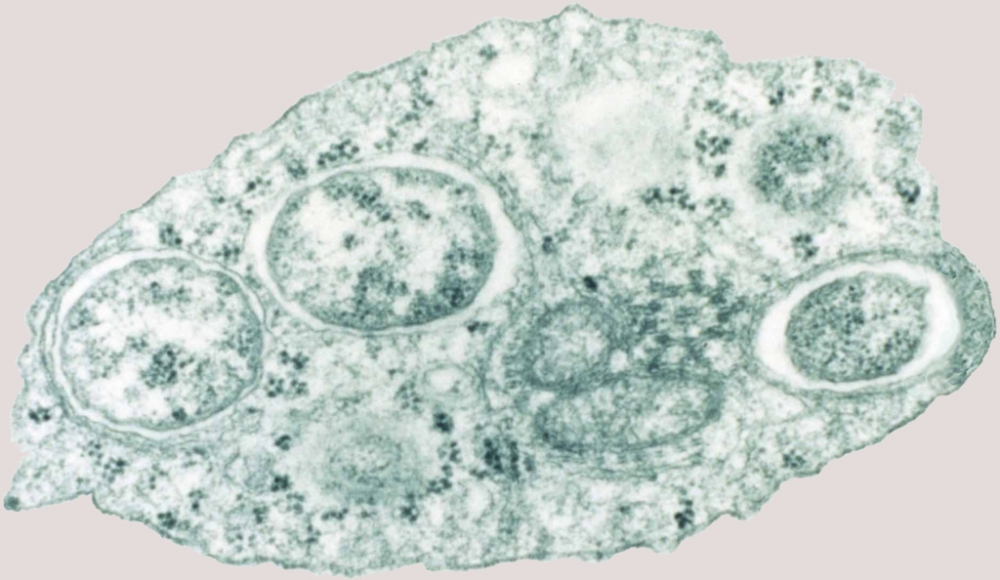

A study by researchers in Brazil and the UK reinforces the hypothesis that Drosophila melanogaster has a mutualistic relationship with Wolbachia bacteria. Their findings can help make the fight against mosquito-borne diseases more effective (transmission electron microscope image of Wolbachia bacteria in an insect cell/Scott O’Neill, Wikimedia Commons)
A study by researchers in Brazil and the UK reinforces the hypothesis that Drosophila melanogaster has a mutualistic relationship with Wolbachia bacteria. Their findings can help make the fight against mosquito-borne diseases more effective.
A study by researchers in Brazil and the UK reinforces the hypothesis that Drosophila melanogaster has a mutualistic relationship with Wolbachia bacteria. Their findings can help make the fight against mosquito-borne diseases more effective.

A study by researchers in Brazil and the UK reinforces the hypothesis that Drosophila melanogaster has a mutualistic relationship with Wolbachia bacteria. Their findings can help make the fight against mosquito-borne diseases more effective (transmission electron microscope image of Wolbachia bacteria in an insect cell/Scott O’Neill, Wikimedia Commons)
By André Julião | Agência FAPESP – A study conducted by researchers at the University of São Paulo (USP) in Brazil and Cambridge University in the United Kingdom shows that common fruit flies (Drosophila melanogaster) are infected by fewer viral species and carry a smaller viral load when they are colonized by Wolbachia bacteria.
The study was supported by FAPESP and the UK’s Royal Society. An article reporting its results is published in Communications Biology.
The findings reinforce the hypothesis that D. melanogaster and Wolbachia have a mutualistic relationship from which both benefit, and not a parasitic one, as has often been thought. This could influence the measures taken to combat diseases transmitted by other insects.
“Wolbachia is present in more than half of all terrestrial insects. For a long time, it was believed to be a reproductive parasite because there are some lineages that change the host’s reproduction to increase its own frequency in the population. Thanks to the advance of molecular biology in the last two decades, however, we’ve discovered that in many cases it doesn’t manipulate host reproduction at all. The only way to explain why it’s so common is that it benefits the host in some way,” Rodrigo Cogni, a professor at the University of São Paulo’s Institute of Biosciences (IB-USP) and first author of the article.
Previous research has found that Wolbachia protects the insect against viruses, but the experiments were performed on animals under laboratory conditions. For example, flies that had not been colonized were inoculated with the bacteria and their survival rate after viral infection was compared with that of other flies that did not have the bacteria.
This is the first time the presence of Wolbachia and its anti-viral action has been verified in D. melanogaster collected in the field, showing that the mutualistic relationship exists in natural populations.
Wolbachia is used to combat viral diseases transmitted by mosquitoes, such as dengue, zika and chikungunya. Studies conducted in Australia and Asian countries have shown that fewer cases of these diseases occur in areas where Aedes aegypti mosquitoes infected in the laboratory with Wolbachia are released.
The premise behind this kind of intervention is that because the bacteria are transmitted from the female to its eggs, Wolbachia-infected mosquitoes eventually predominate and viral replication is blocked in the A. aegypti population, hindering human infection.
The Wolbachia method, as it is known, was created by the World Mosquito Program in 2011. In Brazil, it is currently run in five municipalities by Oswaldo Cruz Foundation (Fiocruz), with the Ministry of Health’s support.
Protection for fruit flies
The study contributes to a better understanding of the relationship between the bacteria and the insects, and will help make activities like these more effective. The researchers collected 1,014 specimens of D. melanogaster in an orchard in Connecticut in the US. Wolbachia was found in 71% of the flies collected.
Using next-generation genetic sequencing techniques, the researchers obtained the total RNA expressed in each fly. The vast majority (93%) contained at least one virus. Of the 30 viruses identified, 17 were known to infect D. melanogaster and 13 had never been associated with the fly species. Several of these are associated with other insect viruses, fungi or trypanosomes.
“Viruses can be present in the flies’ food, environment and pathogens, so we can’t be sure they all necessarily infect the species,” Cogni said. “However, given that many are associated with other arthropod viruses, we believe some do indeed infect it.”
Wolbachia-carrying flies had 15% fewer viruses than flies without the bacteria on average. In addition, viral load (the quantity of viruses in the organism) was lower in flies with the bacteria.
“Previous studies by other research groups concluded that Wolbachia has to be a mutualist or it wouldn’t be present with such high frequency. We’ve now shown that it affords protection for fruit flies in the wild, reinforcing the mutualism hypothesis. However, that doesn’t mean there’s no cost for the flies to host the bacteria,” Cogni said.
Other research had already shown that while higher densities of Wolbachia increase protection against viruses, they also incur higher energy expenditure and hence lower egg production, for example. The study suggests this is a positive cost-benefit ratio.
The article “Wolbachia reduces virus infection in a natural population of Drosophila” is at: www.nature.com/articles/s42003-021-02838-z.
Republish
The Agency FAPESP licenses news via Creative Commons (CC-BY-NC-ND) so that they can be republished free of charge and in a simple way by other digital or printed vehicles. Agência FAPESP must be credited as the source of the content being republished and the name of the reporter (if any) must be attributed. Using the HMTL button below allows compliance with these rules, detailed in Digital Republishing Policy FAPESP.





